Note: We offer a complete review of the JOTO bag below. Our opinion is that this is a great purchase for casual users looking for a cheap way to keep their phone dry. You can purchase the case here. (We receive a small commission if purchased through the links on this page, at no charge to you.)
It’s listed as “#1 Best Seller” on Amazon for waterproof cell phone cases. And for good reason. For under $10, the JOTO Cellphone Dry Bag claims to offer an inexpensive waterproof casing for your phone, allowing you to take it with you to wet locations like the beach, the pool, or the river. Best of all, it claims you can also still use your phone’s touchscreen, allowing you to send texts and take photos.
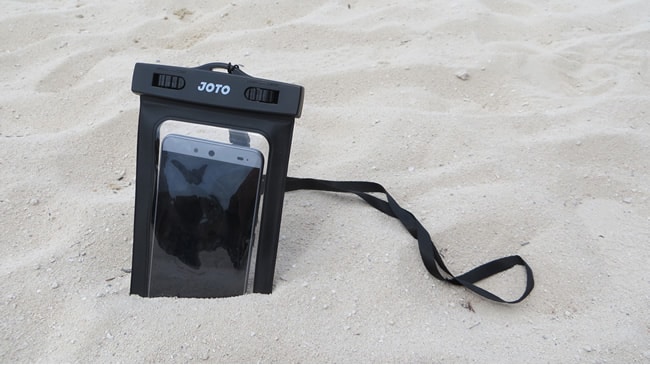
But does it really work to protect your phone the way it claims? We recently purchased the phone case and put it through testing to see how it performed and if it’s worth the money.
First Impressions of the JOTO Dry Bag
We bought the bag on Amazon for an upcoming cruise. We paid $7.99 for it, and the case arrived in just a couple of days. Opening the bag it came in, the first impression of the case is that it seems “cheap”. The bag is made of a flexible vinyl material — similar to a pool float.
The clasping mechanisms at the top of the case are also plastic and are rather loose when opening, with lots of play. Seams on the case were nice and tight, with no areas that looked like they might leak. The neck lanyard was a smooth comfortable cloth that feels comfortable to wear, even in warm climates like the beach.
The case itself measures 8″ tall and 4″ wide. We have a phone that measures 5.5″ tall by 2.75″ wide. It fits comfortably inside the pouch when we take off the phone case. We were also able to fit an iPhone 7 Plus into the waterproof case, but it was a tight fit. Keep in mind you will want to take off your phone’s regular case when you put it into the JOTO pouch.
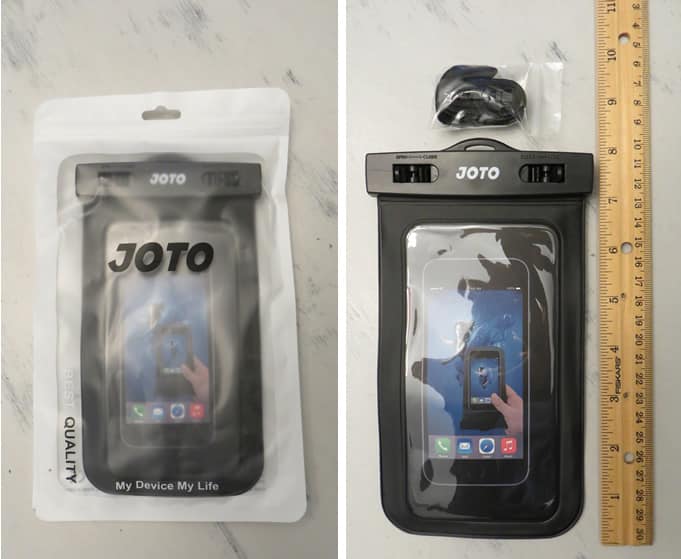
Also included in the dry bag is an instruction sheet when some suggestions for use:
- Check that the bag and accessories don’t have any damage, especially the clip and opening of the bag.
- Do not expose under the sun for a long time.
- Sudden temperature change might cause humidity in the bag. Open and let dry completely.
- Wash the bag if mud, dirt, or sand is found after use.
- Do not use in water above 30 degrees centigrade (86 degrees Fahrenheit)
Below this is also a suggestion that you test the bag before use by putting “dry paper or cotton cloth” in the bag and soaking and shaking it for at least three minutes.
To put it bluntly, our first impressions of the bag were mixed. Costing just $8, it appeared we got what we paid for. The bag is everything it says on the Amazon listing, but we weren’t exactly confident to put a cell phone inside of it. Given the suggestion that we test the bag before using, it seemed like the company didn’t have much confidence in their product. Still, it was only a few bucks, and we decided to test its waterproof capabilities.
Testing the JOTO Case With a Paper Towel
With three of the four edges of the case sealed permanently, it’s up to the top clasp to keep water out of the bag and off your phone. The clasp is held tight with two clips that are turned in to close the pouch and turned out to open it back up.
When closing the clasps, they offer a reassuring tightness; it feels as if the bag is nicely sealed.
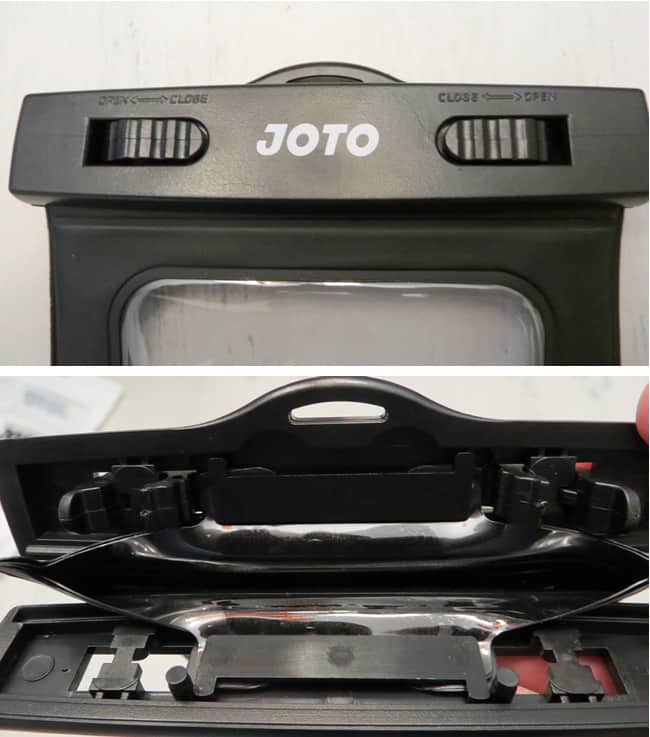
Opening the clasps takes some effort. There is not a large tab to push like when you close the clasps. This is actually reassuring. First, the lack of tabs means that the bag will not accidentally open underwater if it were to get caught on something. It takes some effort to open. Second, since it’s somewhat difficult to get back open, you know that it’s sealed tightly.
For our initial test, we put paper towels into the case to test for any leaks. Closing the clasps as instructed, we then placed the bag underneath a shower for approximately one minute. While under the shower, we also turned the case repeatedly to make sure water hit from all angles.
After turning off the shower and drying the outside of the waterproof case, the initial results looked good. We could see no signs of water entering the case. Opening it up, there is some water that collected in the clasp area, but outside of the case. At the end of the shower test, the paper towel was completely dry. No water entered the phone compartment of the case.
To further test, we wanted to submerge the case completely under water. We filled a bathtub with approximately six inches of water. For reference, the Amazon listing claims waterproof capability up to 100 feet.
After filling the tub, we placed the paper towel filled case into the water. Note that we had to hold it down in order submerge the case. Even in later tests with a cell phone in the case, the amount of air trapped in the case causes it to almost float.
Submerging the case, we turned it over and also shook it to ensure it was leakproof. Finally, we rolled the entire case up to see if this caused any of the seams to fail.
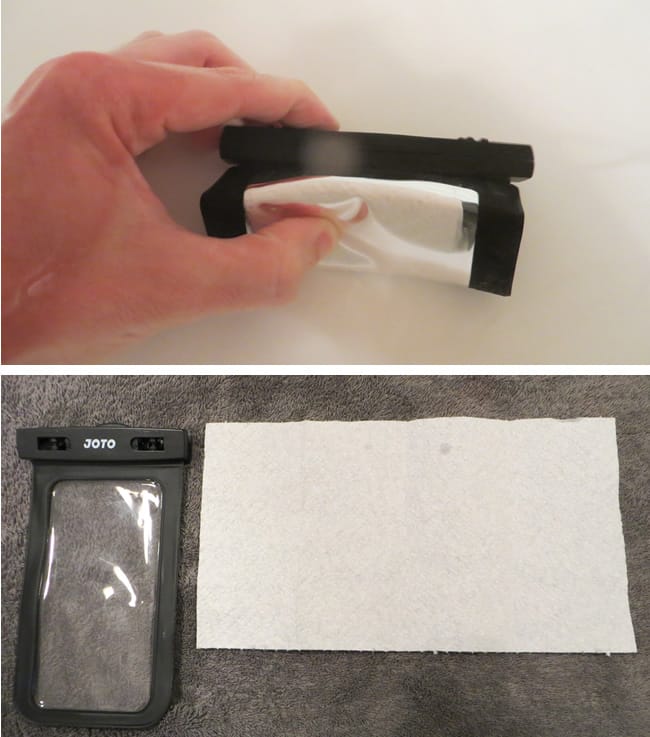
The result? Pulling the JOTO case out of the bath we saw no signs of leaks on the paper towel. Pulling it out of the pouch, the paper towel was completely dry.
Testing the JOTO Case With a Cell Phone
Now came the real test. It’s one thing to put a paper towel in the pouch and submerge it in water. How would it perform with an actual cell phone?
To test, we used an old cell phone that we had laying around. It’s relatively small phone by today’s standards, so it fit easily within the case.
Once sealed up, we first tested the touchscreen. To our surprise, it worked perfectly. Every touch was registered, just as if we were using the phone outside of the waterproof case. Having a layer of plastic between your finger and the touchscreen is different and takes some getting used to before you feel proficient in using it. As well, any buttons on the sides or top of the phone will be harder to press with the phone case in the way.
Note for phones with “fingerprint” scanners: If you have a phone (such as the iPhone 7) with a fingerprint reader, then you will need to turn off this setting before using the case. We tested an iPhone 7 Plus in the case; the fingerprint was not able to be read, leaving the phone locked.
You can turn this setting off, allowing you to use your phone completely within the case. Also, you can still access the camera on an iPhone without having to put in a fingerprint. It’s not a dealbreaker for iPhone users, but does require a little planning before using the case.
Placing the test phone in the water, we liked that it partially floated. This makes it easier in case you lose it in the water — it won’t just sink instantly to the bottom.
Once in the water, we submerged the phone and also shook it vigorously to test for any leaks. We also tested the touchscreen underwater. The screen, while taking some getting used to due to the layer of plastic over it, worked flawlessly. We were able to quickly access text messages, the camera, and anything else on the phone, just as we would on dry land.
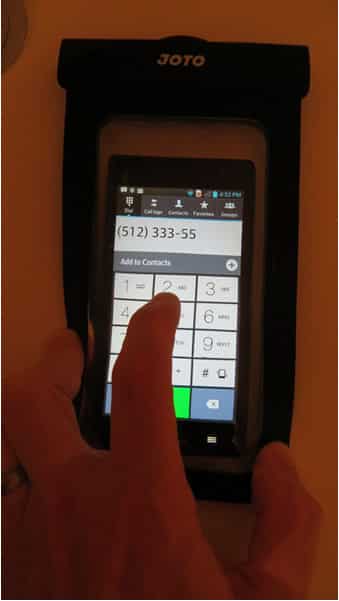
After testing, we dried the case off and removed the phone. No water had gotten in, and the phone was completely dry.
Testing in the Real World
We recently took a cruise to Mexico, where we were able to try the case out in real-world conditions. Specifically, we took the case into the water with us while we snorkeled. We trusted the case enough to put our actual phone in the case to see how it worked.
We first placed the case with phone in the sand at the shoreline, letting a mix of sand and water wash over it. We found no leaks and no sand got into the case. We then took the phone into the water while we snorkeled around for a few minutes. During this time there were no leaks either. Pulling the phone out of the water, it worked perfectly.

Where the phone fell short was using the touchscreen underwater.
If the screen was wet, but we were using it outside of the water, there were no issues. However, submerged in the salt water, the touchscreen didn’t respond well to our touches. There is some response, but it seemed like trying to press the screen would result in touches elsewhere on the phone screen. This made it impossible to snap pictures underwater while snorkeling. Considering we were most interested in keeping our phone dry while in the water, however, this wasn’t a major issue to us. If you are wanting to use the case to take underwater photos, you might try another type.
Taking Photos With the JOTO Cellphone Dry Bag
So we’ve seen that the JOTO dry bag works well at what it’s supposed to do — keep water out and keep your phone dry. But what about photos? With a layer of plastic does that mean any photos taken while in the case will come out terribly?
Outside of the water, we were able to use the phone just as we normally would. We were also surprised by the photo quality. Compare the two photos below. The one of the left was taken without the cover on. The image on the right was taken with the cover on.

As you can see, there is no discernible difference in the photo quality, which actually surprised us.
Summing Up the JOTO Cellphone Dry Bag
What We Like: An inexpensive way to protect your cellphone from sand and water. Low profile clips mean they won’t get snagged on things and accidentally open. Thick vinyl covering isn’t easily punctured or torn. Pictures were crisp and clear when taken inside the case.
What Can Be Improved: We’d like the ability to take photos underwater. Plastic clasps at the top of the bag feel cheap. We don’t feel like it would hold up to years of use. Instead, this case is something we think you’d want to replace regularly.
Final Take: In total, the JOTO Cellphone Dry Bag does exactly what we hoped it would do. It gave us an inexpensive way to carry our phone with us and keep it dry, even if we went swimming. Considering it costs just $8 on Amazon, we think anyone wanting to take their phone to the beach should invest in one of these cases as cheap protection.
Note: We receive a small commission if you purchase the product through the Amazon links above. The opinions expressed are completely our own.

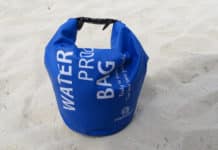





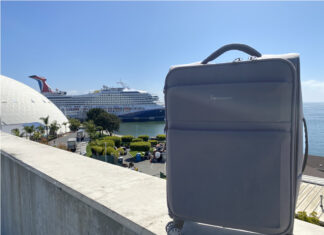
Product latch broke after 5 months of light use (take into the shower daily).
No product/customer support on Amazon or on product website.
Waste of money. Worse yet, both Amazon and Joto suck for customer satisfaction because there is no way to find someone to talk to about this. No contact information.
Great review!
I’d like to send you a link to a YouTube video, where the yoto has been involuntary tested for 9 full months! A scuba diver found the iPhone where it had been resting under a waterfall, in gravel and dirt for 9 months after the unlucky owner lost it. The phone was still dry and working after a recharge! The owner was found, and even had a recording of the exact time he dropped it in the water.
Here’s the link :
https://youtu.be/fN7zAr-wKmU
Thanks for sharing. That’s amazing.